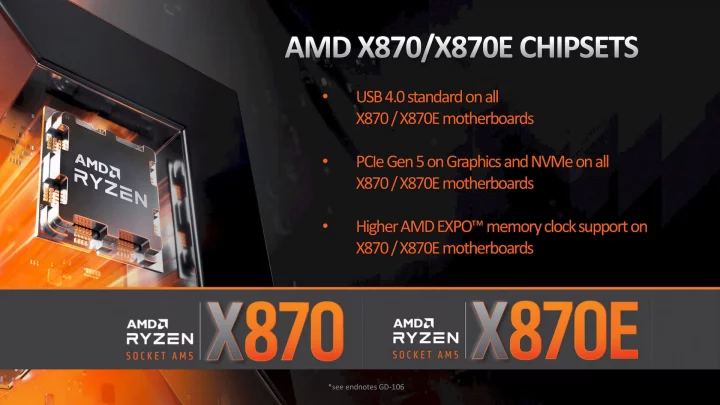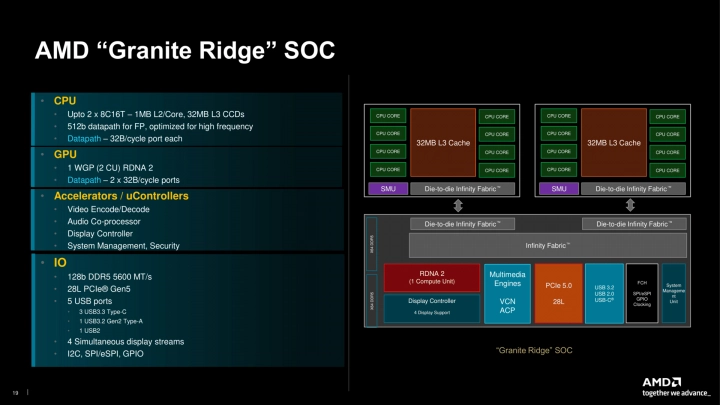Not long ago, we had news here that with the Intel LGA 1851 platform with Core Ultra 200 (“Arrow Lake”) processors, one innovation in memory will be premiered – CUDIMM modules, which have an integrated clock generator and can therefore work at higher frequencies. For a while it was not certain whether this would be an exclusive feature of the Intel platform, but it looks like CUDIMMs will also be able to be used on AM5 boards with Ryzen processors.
CUDIMM support could possibly be announced alongside the X870 and X870E chipset boards which are due out now. This follows from information published by MSI in one of the presentations of new boards in Asia.
MSI says that the X870 and X870E chipset boards will have an improved PCB and memory slot design to improve the ability to run stably at high frequencies – by making the signal better and less degraded on the way from the processor to the modules. But that will not be all, part of the news should also include support for CUDIMM memories, i.e. those mods with a built-in clock signal generator (CKD). MSI has confirmed that this feature will also be supported on Ryzen processors. It is not yet clear whether it is also planned to be put into operation on older boards with generation 600 chipsets (such as B650, X670 and their “E” variants), or if they will be officially supported only on generation 800 platforms.
CUDIMM i pro Ryzen 9000 (a 8000)
Initial (but maybe not yet complete, more on that in a moment) support should already be in AGESA 1.2.0.0 and AGESA 1.2.0.1, while BIOSes with the following version 1.2.0.2 are now slowly appearing, which reduces the long latencies when communicating between CCX at Ryzen 9 9900X and 9950X.
Overclocker and MSI overclocker TOPCC posted a video where he discusses CUDIMMs (as well as CAMM2 modules, which MSI is also testing) and confirms that support for them on the AMD platform is being worked on. However, for now it will probably be limited to the new Ryzen 9000 processors with Zen 5 architecture and Ryzen 8000, which are desktop APUs based on the Hawk Point chip.
Ryzen 7000s (desktop models with Zen 4 architecture) are not supported, but this may not be a direct hardware limitation, but rather an incompatibility with their firmware. It is therefore possible that they will receive support later. The development of new features and technologies often works in this phased manner, with the highest priority products being rolled out first and the rest following later. Anyway, at the moment, it is said that the functioning of CUDIMMs with Ryzen 7000 processors is prevented by some unresolved compatibility.
CUDIMMs don’t seem to work completely transparently to the host platform, which has to support them to some extent. From the video from TOPCC it seems that by default the CKD chip generating the signal for the module is not used, so if you put the module in an older board without official support, it should work, but in the so-called “bypass” mode, where it behaves like a regular module no CKD (so no CUDIMM benefits). However, Ryzen 7000 apparently has a problem with this bypass mode, so the computer does not boot with such a module.
In order to use the module as a CU-DIMM with chip clocking provided by the CKD chip on the module, a proper initialization is required, which is probably why this technology needs a compatible processor and a new (modified) AGESA firmware version. According to TOPCC, it is possible that these modules will be automatically detected in the boards and set to low frequencies such as DDR5-3600, which will have to be automatically changed to the desired faster profile, or the board will set the profile automatically after boot.
So far, it is not clear from the available information whether CUDIMM modules with truly active CKD will be enabled immediately upon release, or it will come only in later firmware updates. This will hopefully become clearer after the official CUDIMM support announcements. However, it is possible that the official launch and announcement will also have to wait until the real availability of CUDIMM modules on sale.
Will CUDIMMs benefit Ryzens?
But it is a question how much fast memories will help on Ryzens, because their architecture is different from Intel and the optimal operation for them is at DDR5-6000 or DDR5-6400 speeds without the divider (1:1) that is needed for higher clocks ( note: Intel also uses a 1:2 divider for DDR5, so-called Gear 2). Turning on the 1:2 divider degrades latency, which eliminates some of the benefits of higher throughput. Above DDR5-8000, however, the benefit of higher bandwidth could already bring more benefits. However, there is one more thing.
For AMD, the memory bandwidth may not be the main limit, because at the same time, the bandwidth of the Infinity Fabrid connection between the IO chiplet and the CPU chiplet (the CPU cores contained in it) is also limited. The throughput between the IO chiplet and the CPU chiplet should be 32 bytes per cycle for reads (and 16 bytes per cycle for writes, for which the throughput is half that, since typical workloads don’t have a close to 1:1 ratio of reads to writes; AMD already uses this trick from Ryzen 3000). If you run the Infinity Fabric at 2000MHz this should mean that a single CPU chiplet can read data from memory at a maximum of 64GB/s and combined writes and reads can be a maximum of 96GB/s, although with DDR5-10000 modules you should theoretically have a throughput of 160 GB/s.
This means that only the Ryzen 9 9900X and 9950X processors will take full advantage of the extreme memory speeds, since they have cores in two chiplets, each of which has one such interface to the IO chiplet, so that double the throughput can be used in multi-threaded tasks. Theoretically, they should therefore see an increase in performance in applications that are currently strangled by memory throughput (this could be seen in yCruncher with AVX-512).
Increasing the memory clock rate can have a secondary positive effect even if the program does not directly benefit from higher throughput. This is because if the latency in cycles is the same, at a higher frequency one cycle is shorter. For this reason, higher frequencies can also help in games (if not achieved by releasing latencies in the cycles). So it is not completely excluded that CUDIMM modules will help in games as well. It’s just that you can’t expect big benefits, because it will probably mainly be this secondary effect (and it will first have to overcome the effect of the deterioration of latency due to the use of a 1:2 divider).
Resources: TOPCC, VideoCardz
Source: www.cnews.cz




